
Terminator 2: Judgment Day — He Said He Would Be Back
The fight for the future of humanity continues on in James Cameron’s epic sci-fi action sequel, as shot by cinematographer Adam Greenberg, ASC.
Unit photography by Zade Rosenthal
The Terminator (1984), an imaginative man vs. machine mini-epic, started out as a low budget phenomenon. On a $6.5 million budget, it managed to make an international star of Arnold Schwarzenegger, catapulted James Cameron to the top ranks of directors and made its producers happy and rich. It also had a nice trickle-down effect on Polish-born cinematographer Adam Greenberg, ASC who went on to shoot so many American films he has since become a United States citizen. Many people believe The Terminator was Greenberg's first film; in actuality, he had shot nearly 90 features all over the world before he met Cameron and helped create the film that made Arnold a household name synonymous with fast paced, spectacular action.

Now, seven years and another 30 features later, Greenberg has practically finished shooting the long-awaited sequel, Terminator 2: Judgment Day. Though critics have tended to focus on the film's extraordinarily large budget (over $100 million), chances are good the film will be well worth its cost. On this kind of budget, with Cameron's penchant for drop-dead action sequences, Terminator 2 should give most of its audiences heart attacks before the final reel unwinds.
“Because of the complications of this production, I was very squeezed for time. Before I even started, I was behind.”
— Adam Greenberg, ASC
Greenberg says, "Although I don't know the exact numbers, about half the budget went before we started shooting: Schwarzenegger's salary, buying out the original producers, et cetera. This is today's movie in Hollywood! Very scary." And what was it like to go from shooting a low-budget masterpiece to the most expensive film in history in less than a decade? Greenberg laughs and says, "I'm sorry. I didn't want to."
Ironically, Terminator 2's big budget did not buy Greenberg the freedom and time one would have thought: "I told Jim Cameron, 'We've got maybe 10 or 15 times what we had on the original Terminator, but, as cinematographer, I have less time to do my job than on the first one, than on any movie I've done in the last five years!' Because of the complications of this production, I was very squeezed for time. Before I even started, I was behind. For a cinematographer, you'd think for this amount of money, I could have anything I want, but I did not. I didn't have time, but equipment-wise I had what I needed."
From Greenberg's point of view, the toughest thing about making Terminator 2 was dealing with the sheer physical size of the production. "It was like being the head of a big battalion," he says. "The numbers of the crew were incredible, and we had very big lighting setups. On this movie, Jim Cameron and the producers wanted to go big — bigger than maybe they expected — and all the way through the film, big sets and complicated action and effects; nothing was simple. We used lots of cameras, sometimes nine cameras on a single shot, including crash box cameras for the action scenes. There's a lot of special effects — this entire movie is special effects — but l've been through all that before, technically. For me, the most complicated aspect was not dealing with the special effects, it was the size of the operation.
"When I came on this show," Greenberg adds, "I mentioned that it might be good to have a Steadicam around, but Jim didn't think he would use it very much. I just said, ‘You never know.’ We ended up hiring Jimmy Muro and kept him working all the time. I thought it would be good style-wise, and it works well with this type of show because Jim likes to move the camera a lot. There's not one static shot: Even shooting in a closet, the camera moves; inside a car, the camera moves!"
Second-unit photography was headed by Mike Benson, who was formerly John Alcott, BSC’s assistant, and who has assisted Greenberg for the past five years. "He was working for almost six months, practically the entire show, separately from us," Greenberg says. "He was practically filming another whole movie right alongside our movie. For me to oversee this, to coordinate everything so we'd get the same look in both units, was very difficult, but Mike's worked with me before and he's very good."
If that doesn't explain just how big the production was, Greenberg offers the following example: "When I started working on the film, I asked the sound man, 'How many Motorola walkie talkies do we have?' He said, '187,'" Greenberg relates, his voice rising in astonishment. "187 Motorolas? I never needed a Motorola on any film I've ever done, but I needed it on this show because of the huge distances we were filming over. The first few weeks I didn't use it but then I found I was losing my voice, so I had to adjust myself to this huge production. How else could I talk with my crew?"
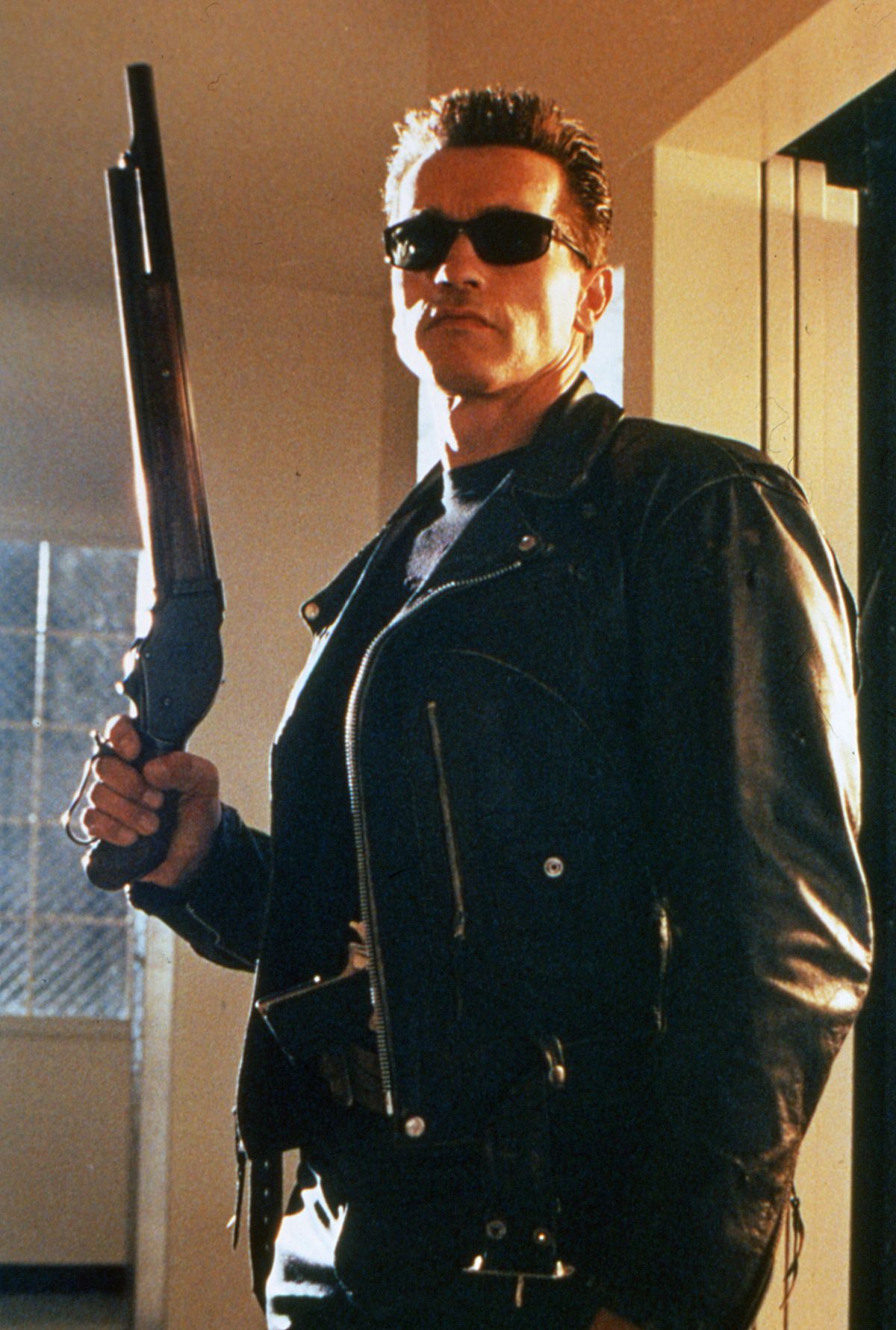
As for the story of Terminator 2, the most this reporter was able to learn was that the entire film is one long chase, very much like the first movie, only bigger. Arnold's character, now a good cyborg, is chased by the new Terminator T-1000, as indestructible as the first Terminator, only deadlier: The improved model has the ability to physically change his appearance and adapt to any situation. Beyond that, as to plot, Greenberg's lips were sealed by the production company. "This production was very strict," Greenberg says, "I've never seen this before. The moment I got the script, I signed a piece of paper stating that I would not reveal any information about the story to anybody. Every time we received a new draft of the script we had to re-sign the same paper. I've never seen such a thing. I don't think it's needed, but I don't want to be sued by the production."
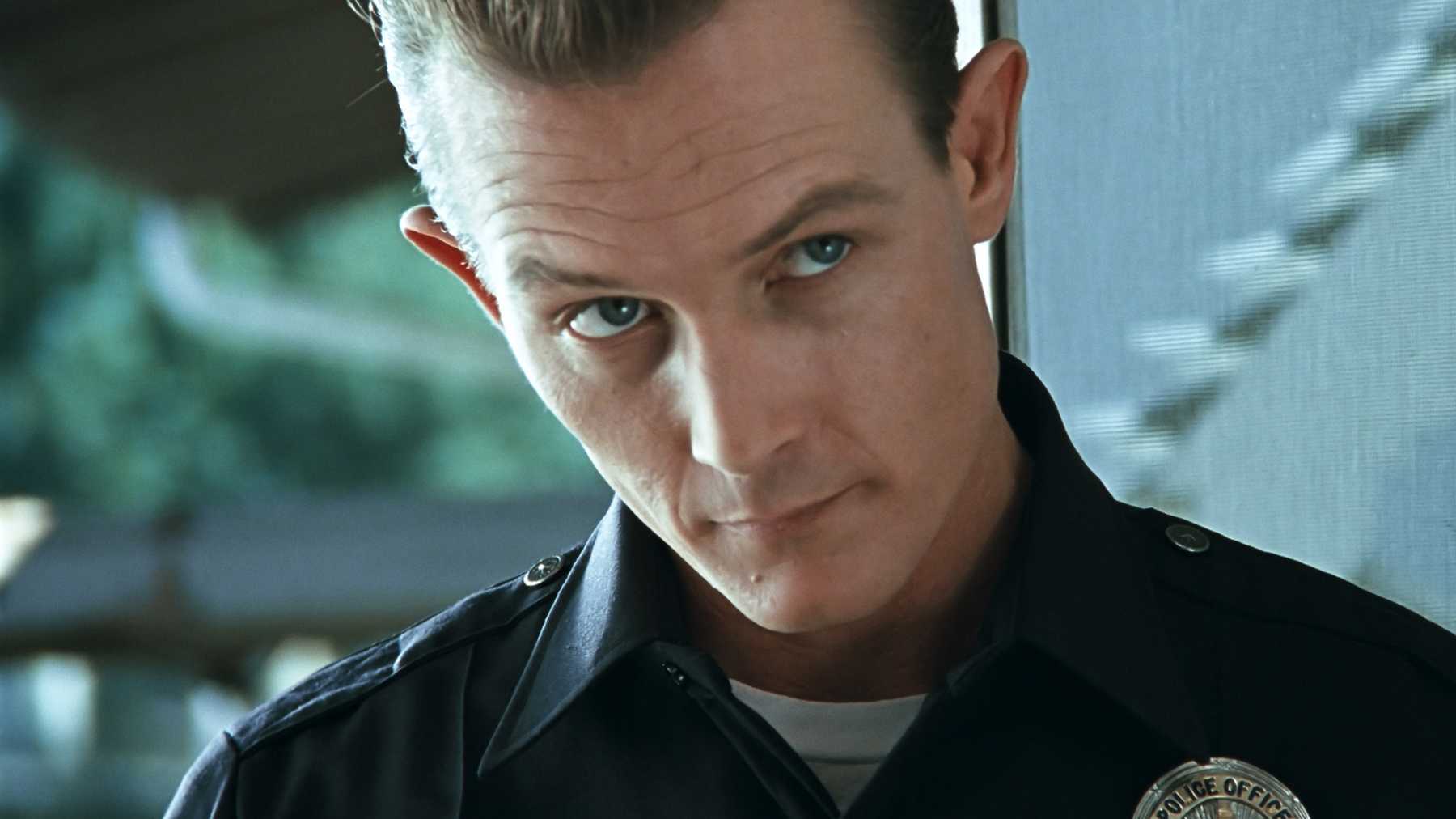
According to Greenberg, Terminator 2 doesn't stop for a moment. The chase aspect called for an incredible amount of driving, which forced Greenberg to come up with a radical approach to handling one of the most common special effects chores on any film: rear projection photography. "We needed to use a lot of rear projection," Greenberg acknowledges, "but I was looking for something more for this film, a way to replicate the real situation when you drive in a car. I created an interesting rig, which was designed by my grip, Bobby Gray, and it was very exciting visually. We built a hanging rig above the process stage and the car, which had moving lights on a circular track that could go backwards or forwards. Since the lights are really moving, it creates the illusion that the car is moving. Also, the lights reflect off the windows and hood of the car and the faces of the actors. The length of the rig was more than 20 feet and it worked very well. We could lower and raise it on a lift and it created a very good illusion. The rear projection looked incredible!"
The trick with this new rig was keeping the overhead lights from shining on the rear-projection screen. "We hung a huge black cloth in front of the screen," Greenberg adds, "and the lights disappeared into a tunnel of black cloth on the side closest to the rear screen. The tunnel was open in front so the lights could shine on the front of the car, and closed in back because we never showed the back of the car against the rear screen. This deflected the light away from the screen and into the black cloth. I've never seen this technique done before. I did something like it on Near Dark, with the same grip, Bob Gray, and this is where we got the idea to use it for this show. When we finished using the rig on Terminator 2, I suggested to Bill Hansard, who handled our rear projection, that he should take it over at his new studio in Culver City."
“Before The Terminator, I didn’t do any science-fiction movies — I did war movies, love stories and comedies.”
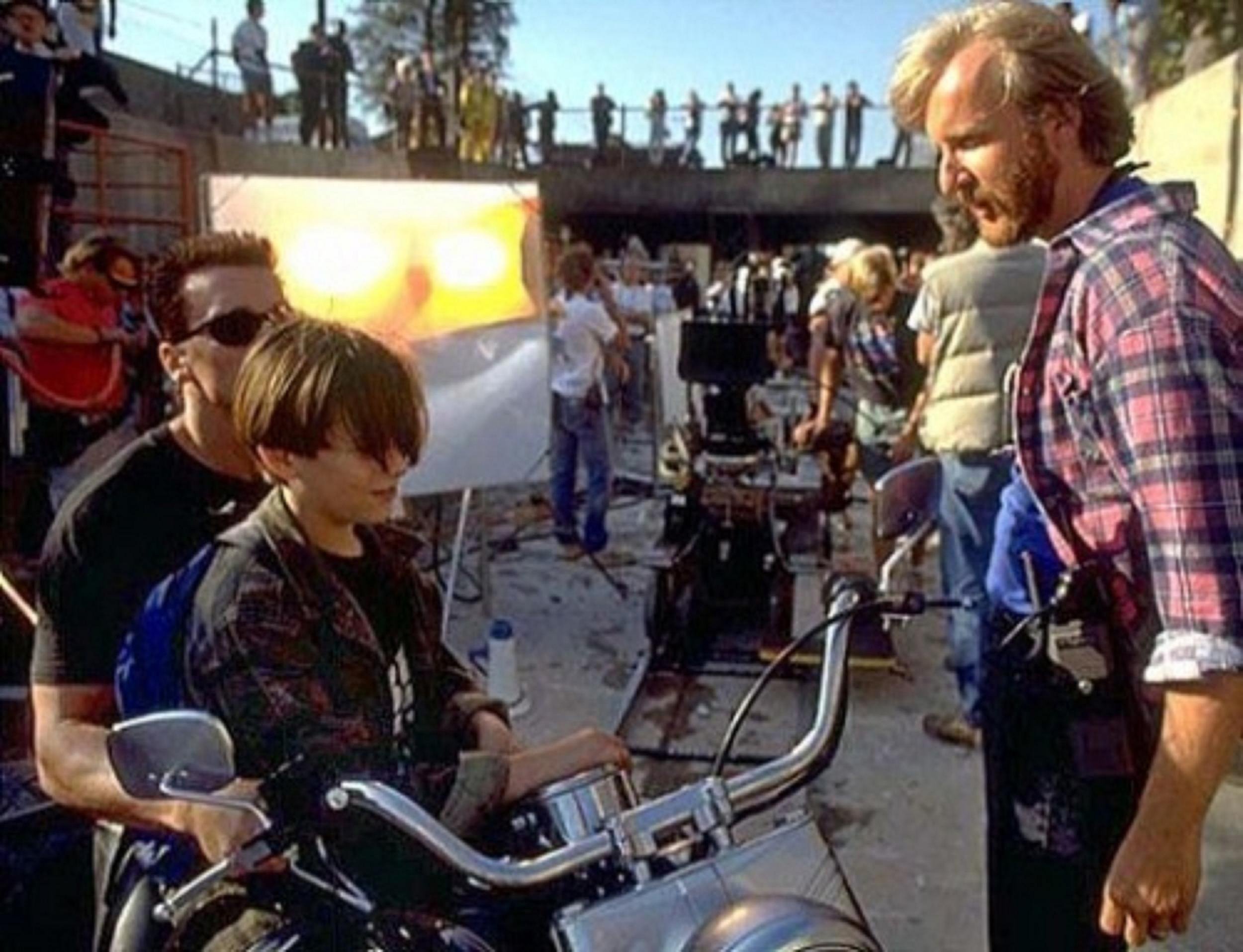
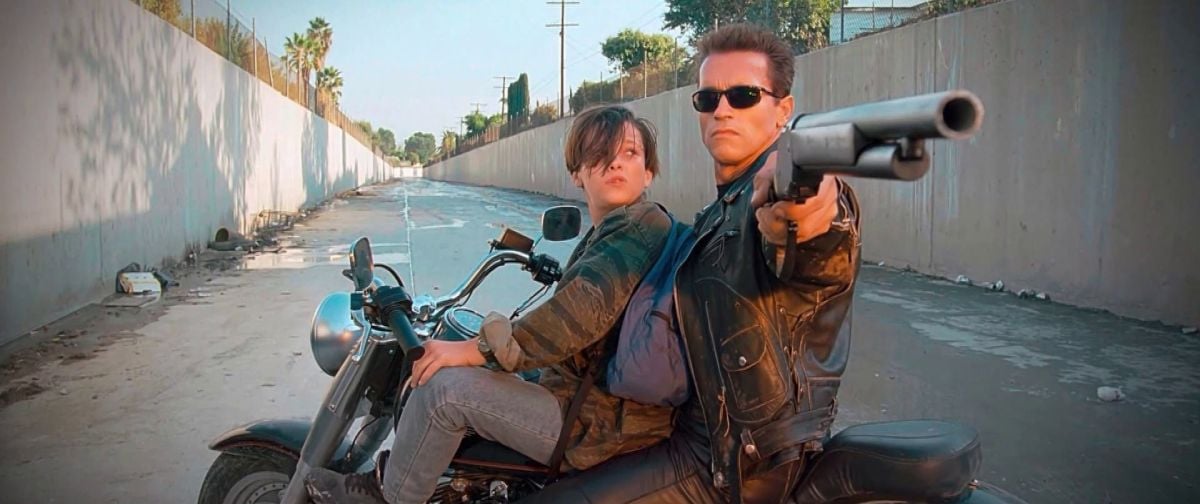
The extensive rear projection chase sequences were filmed at night on stages in Valencia because the crew was already on a night schedule and the production didn't want to upset the crew's already delicate equilibrium by changing over to a day schedule. "I feel like a vampire now!" Greenberg laughs. "This film was all shot at night — there were no days! Out of 120 shooting days, we may have had three weeks of exteriors, and even most of those were at night. I like nights because you start from nothing. I wet down the streets to increase the contrast, not for the beauty reflection of the water. What bothers me is when I see gray at night — I only want to see black and white. I want to make the night dark, so I wet down the pavement to eliminate the gray of the sidewalk. The pavement absorbs the water and becomes dark. If I could paint the sidewalks black, I would. Sometimes I ask to wet down the cars on the street — they don't read like they're wet down, but it knocks down the color.”
As with the original film, Terminator 2 opens in the midst of a very violent future, torn by a bloody war. When asked if he's happier with the current war footage vs. that in the original film, Greenberg's reply is fast becoming the motto of Terminator 2: "I think it's the same, just bigger," he says. "The future war in the first film was shot somewhere in East Los Angeles with some garbage and a few lights hanging around and effects explosions. The one in Terminator 2 had the same look photographically — it was just much bigger."
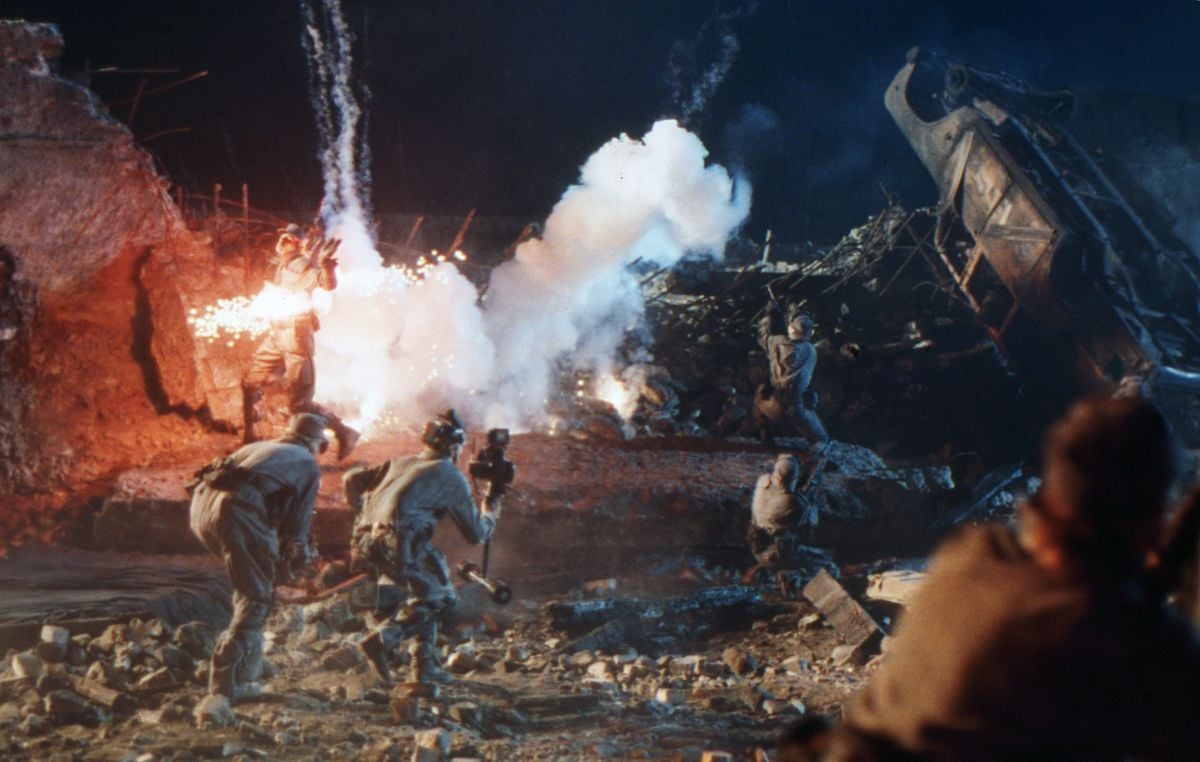
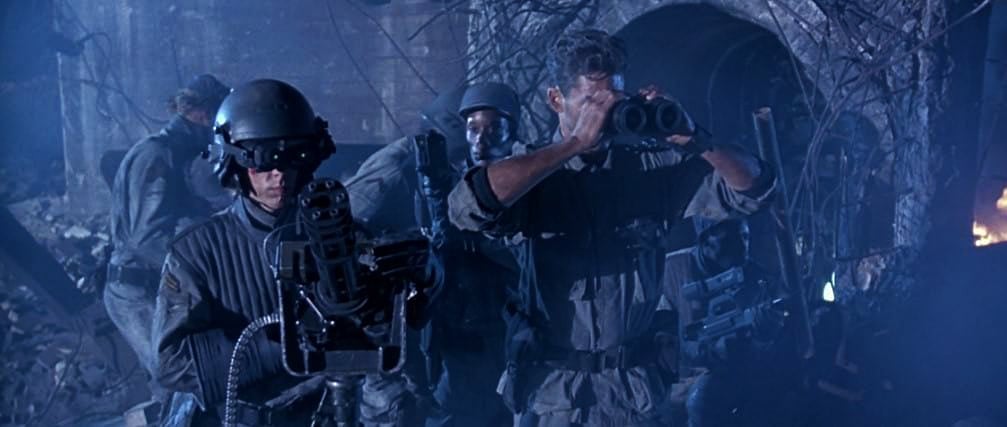
Cameron and Greenberg scouted a number of locations before settling on the perfect place to stage their battle: Oxnard, California. "It was a very big area we found to destroy. It was an abandoned steel mill which somebody would've dynamited and we were able to use that as our background for the future war. It was a huge exterior, a half mile by half a mile. I lit it with Musco lights. We dressed the location with more set pieces, people fighting, spotlights hitting people and explosions. We shot some of that practically, and then, in postproduction, Gene Warren and Fantasy II added the spaceships fighting.
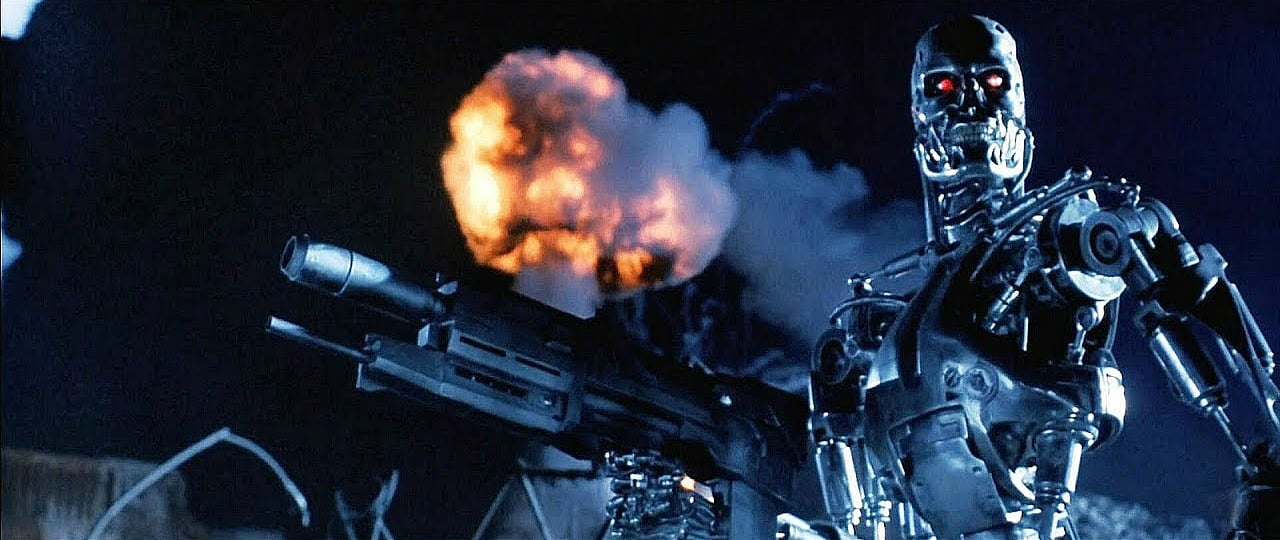
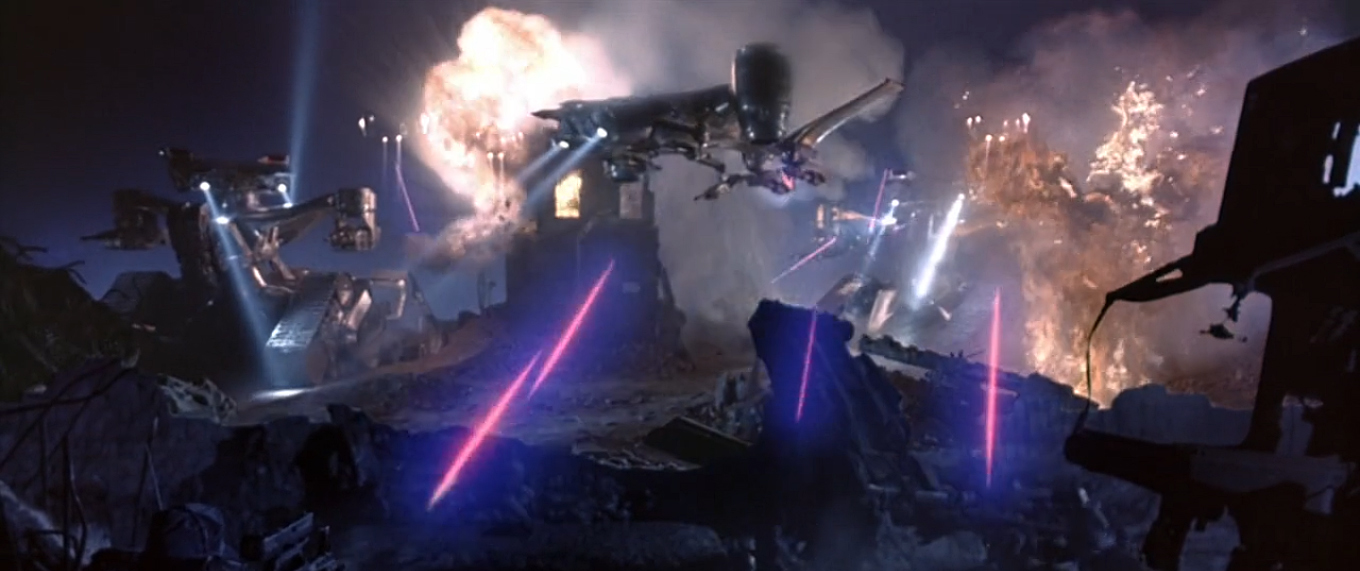
"We originally were planning to use a helicopter to add moving interactive light on the set that would seem to be coming from one of the spaceships, but it was too much of a headache, too time-consuming, too noisy. We decided instead to use 100' Condor cranes with Xenon lights to blend with the post-production ships so it would look like interactive light from the miniature ships on the real buildings. It's a very spectacular sequence."
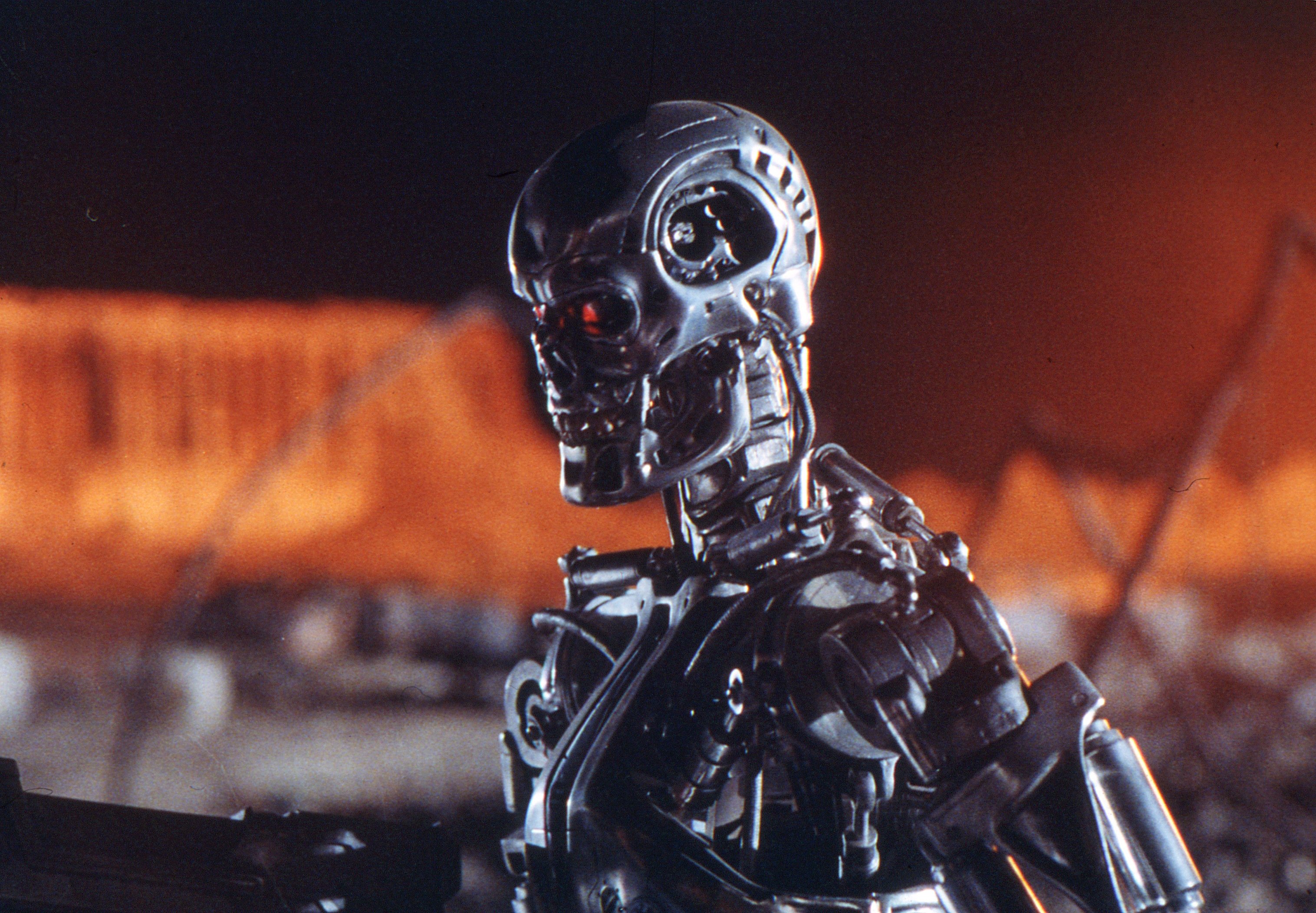
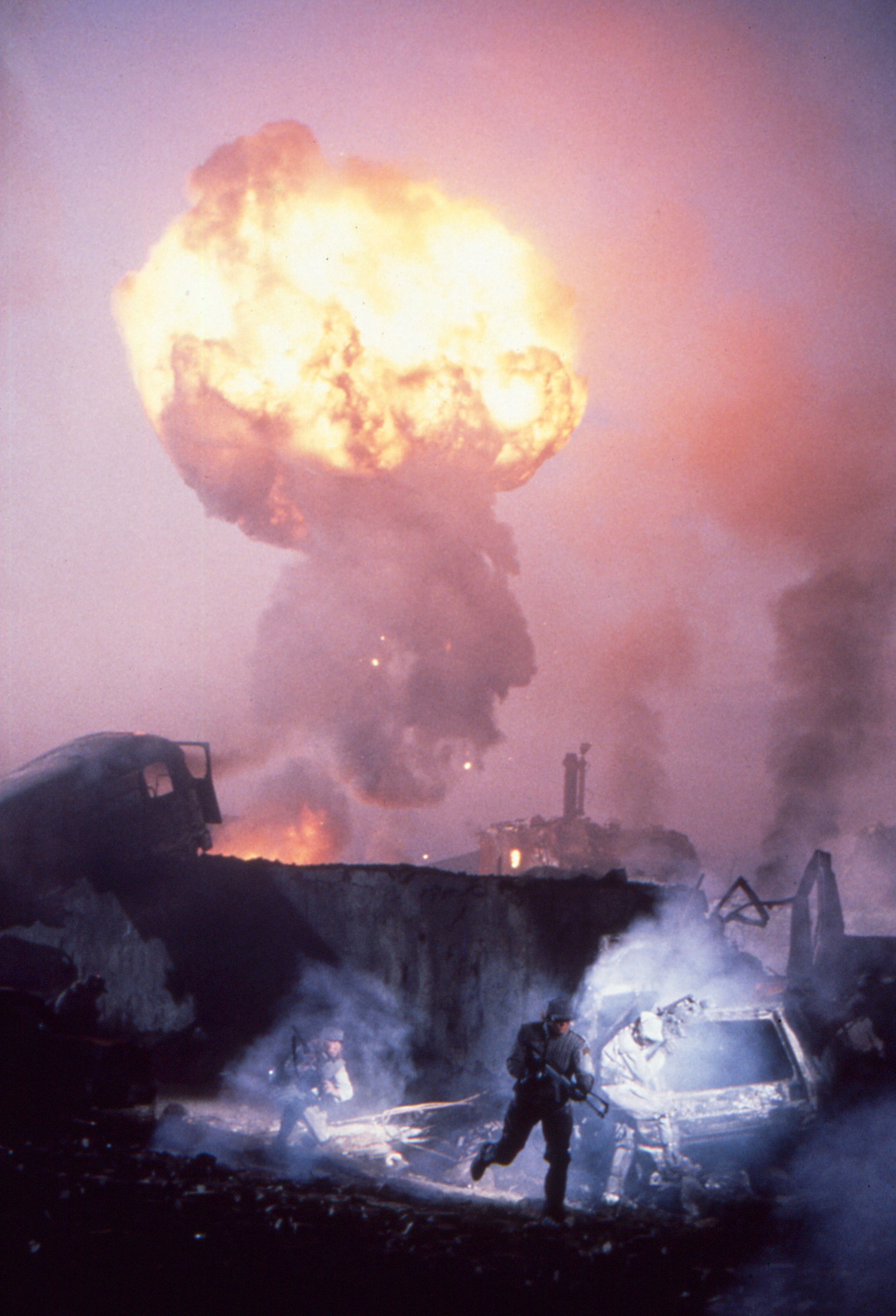
Another remarkable sequence was set in a mental hospital where Sarah Connor (Linda Hamilton), the heroine of the first film, has been placed for observation. Here, Greenberg opted to go against the tradition of making a hospital seem bland and antiseptic.
“We decided to make the hospital a place watched by guards with strong spotlights outside shining through the windows, which gave us an overexposed, very bright look.”
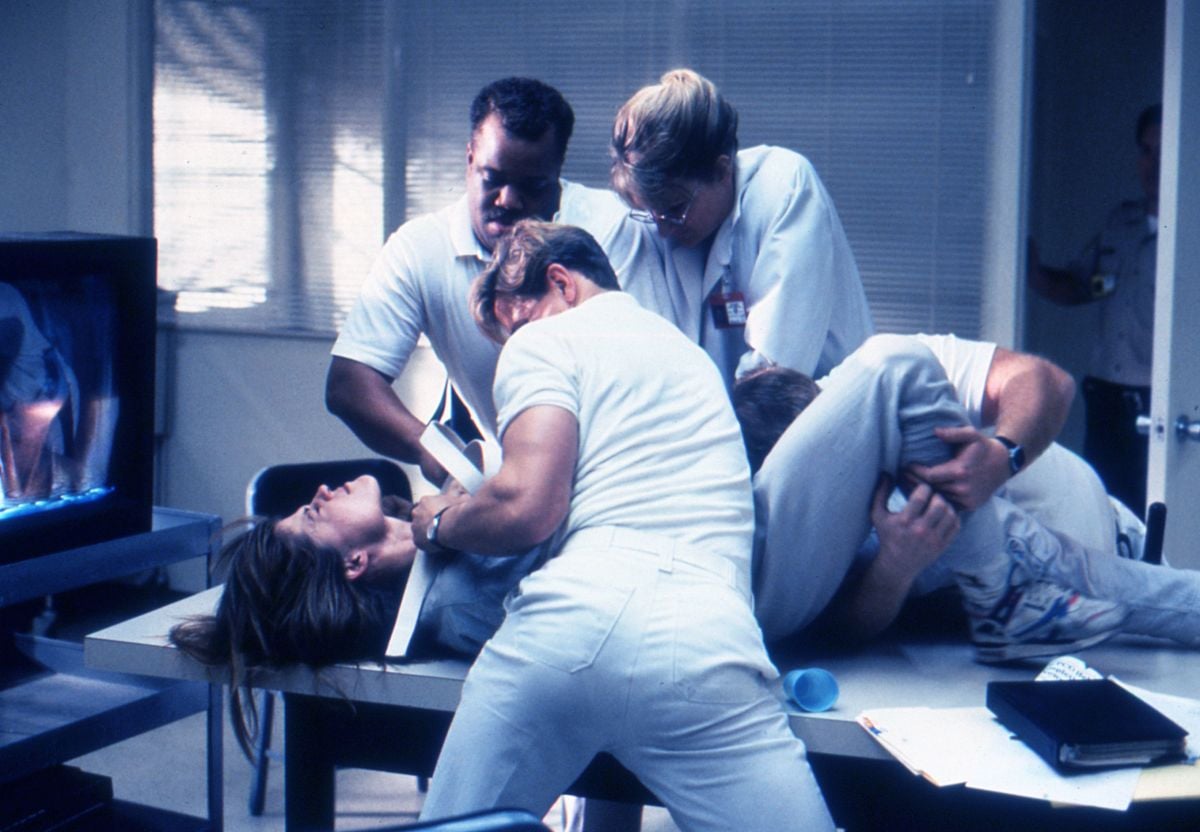
"Usually, in a hospital, you'd use fluorescent tight and it's very boring; we didn't want to go back to this," he says emphatically. "We decided to make the hospital a place watched by guards with strong spotlights outside shining through the windows, which gave us an overexposed, very bright look. We put Xenon tights on the roof of the hospital shining down through the windows into the hallways and it created a different look than you'd expect for a mental hospital. It's not exactly a soothing environment, but I think it's a more creative approach and it works better for the story.
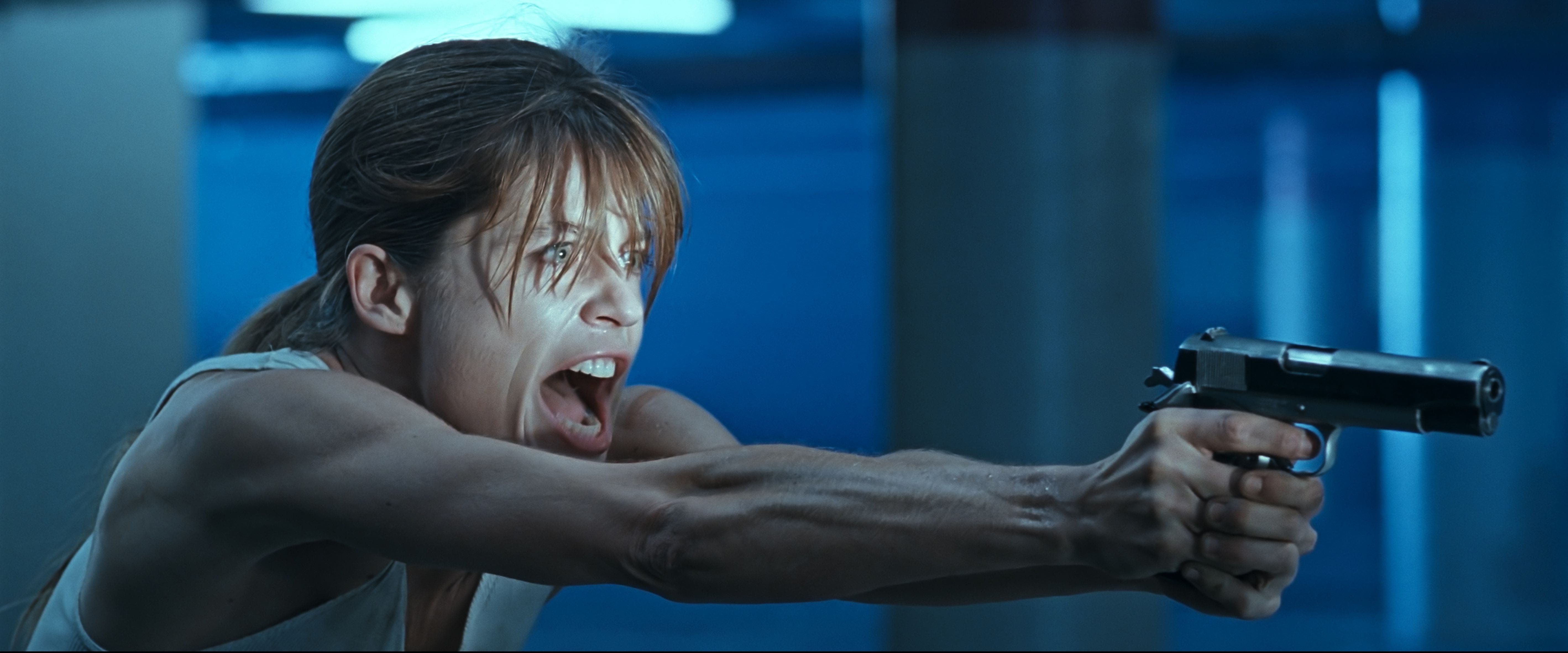
It's also extremely complex from a lighting standpoint. Since the only light in the scene comes from outside the building, Greenberg was always in danger of losing his actors' faces. Even more worrisome was the fact that the walls and floor of the hospital were white, a color that often strikes fear in the heart of cinematographers. "I don't mind white too much," Greenberg says calmly. "In this story, because I was using cool colors, the white wasn't really white, it was slightly bluish. As far as making sure I would be able to get enough light on the actors, I did a few tests. We put Xenon lights on the roof of the hospital, and I directed the light through the window so it would bounce off the wall and throw light into the actors' faces. This was a huge setup, think of all those lights! We had to light huge hallways with big Xenons outside the windows, and we had no fill light at all. Since we only had the one source of light, sometimes Linda would be in the light and sometimes in the dark, or sometimes she'd be lit only by the bounce light coming from the walls."
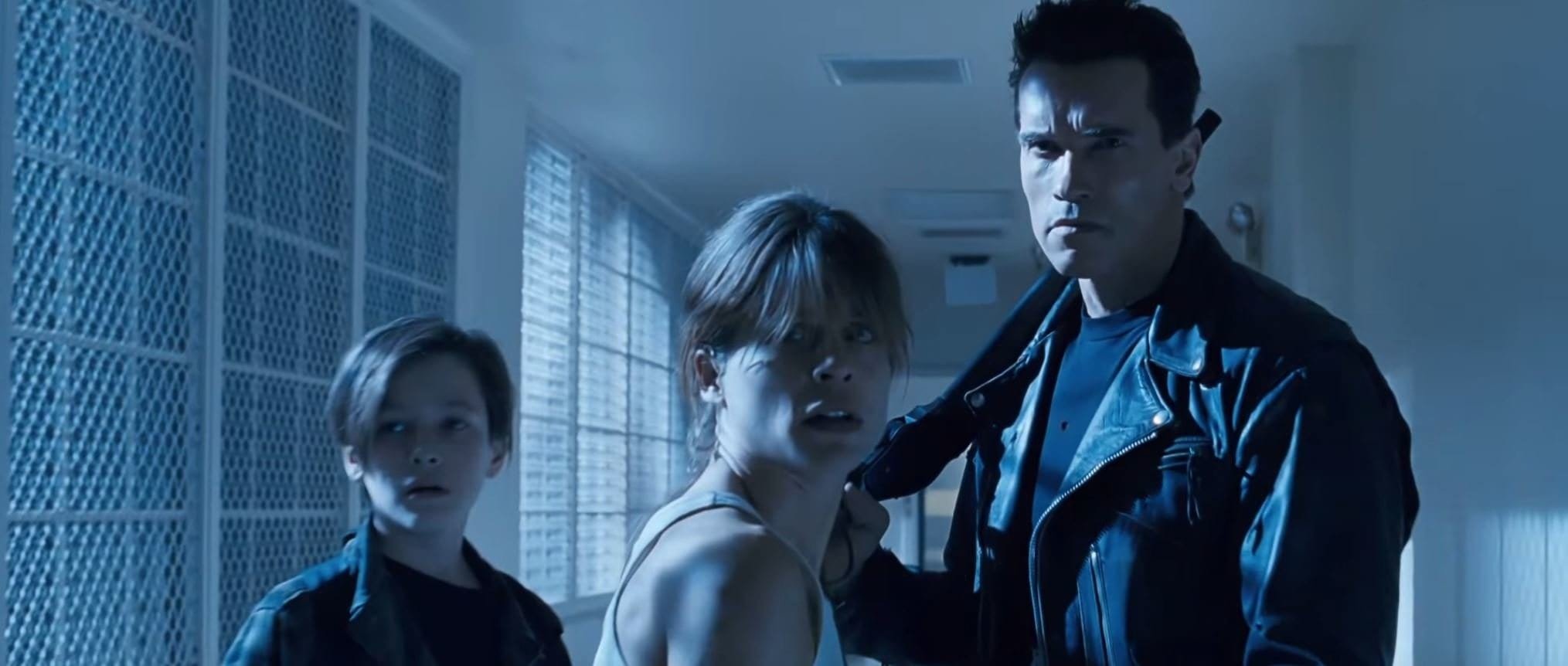
Greenberg carried this hard approach to lighting throughout the film, altering the look through a wide range of gels. "I didn't want a beauty look, I wanted it to look strong," he affirms. "Throughout the movie, I tried to stretch the colors as much as possible. I was using a lot of deep blues and cyan, and on the other hand, a lot of deep, warm colors. I found this approach worked very well for most of the film."
Nowhere was Greenberg's approach more effective than in his lighting on the Terminator robot. While it could be argued that it was Greenberg's photography on the original film that helped make Schwarzenegger a star, the cinematographer feels his best visual work is in the sequel. "I think I shot Arnold much better in this movie than in the original," he concedes. "The first movie was made seven years ago and I was new in town. We had a very small crew and the movie was much smaller. On the first film I learned how to light Arnold, so on this one, I knew what to do already and I was able to use it from the beginning."
“I always lit the Terminator with a cold light to make him less human. I used blue and cyan gels on the lights, which was good for Arnold and the story.”
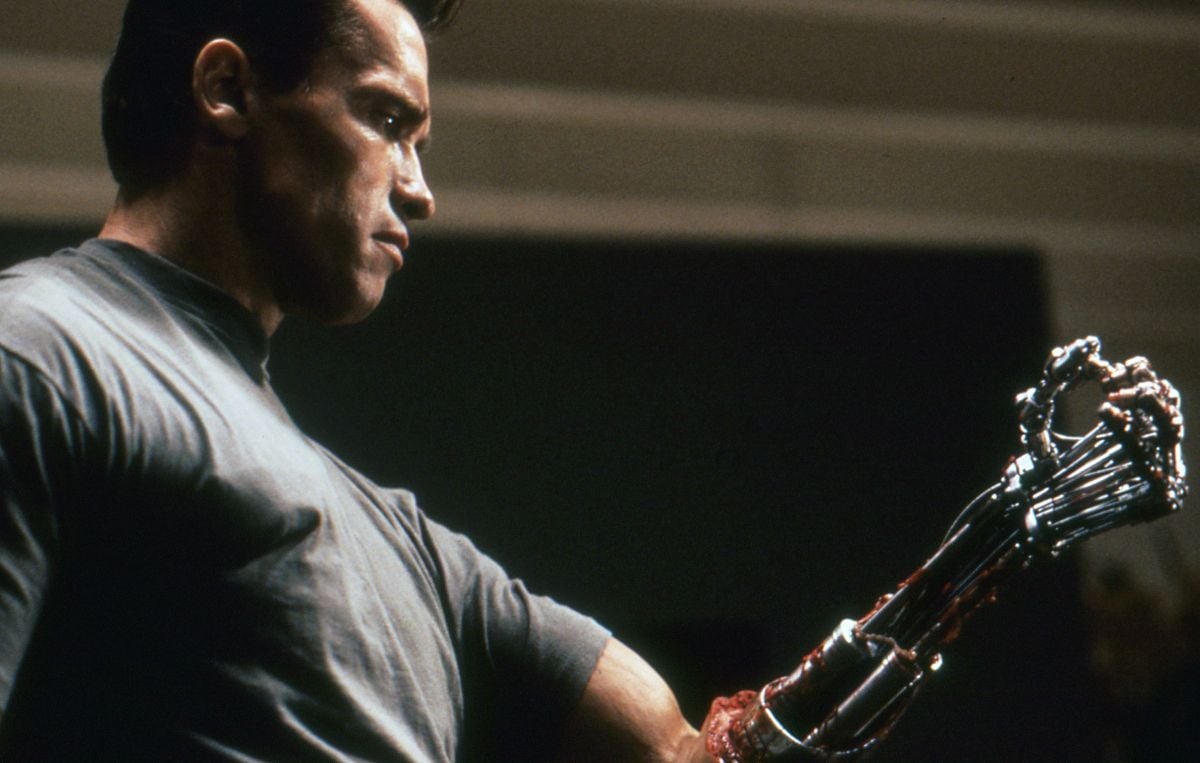
Basically, Greenberg used his lighting on the Terminator itself to convey the essential savagery of the character. "In the first movie, I used a metallic blue light on him, and I tried to maintain that same style of cinematography in this film," he relates. "I always lit the Terminator with a cold light to make him less human. I used blue and cyan gels on the lights, which was good for Arnold and the story. When I hit Arnold with some very good, strong light, he looks like a piece of sculpture; he looks incredible. I used a lot of top light to increase the shadows and create a harder, stronger look. The harder the light, the better he looked. I'd light the other actors softer, but on him I'd always go hard and cold."
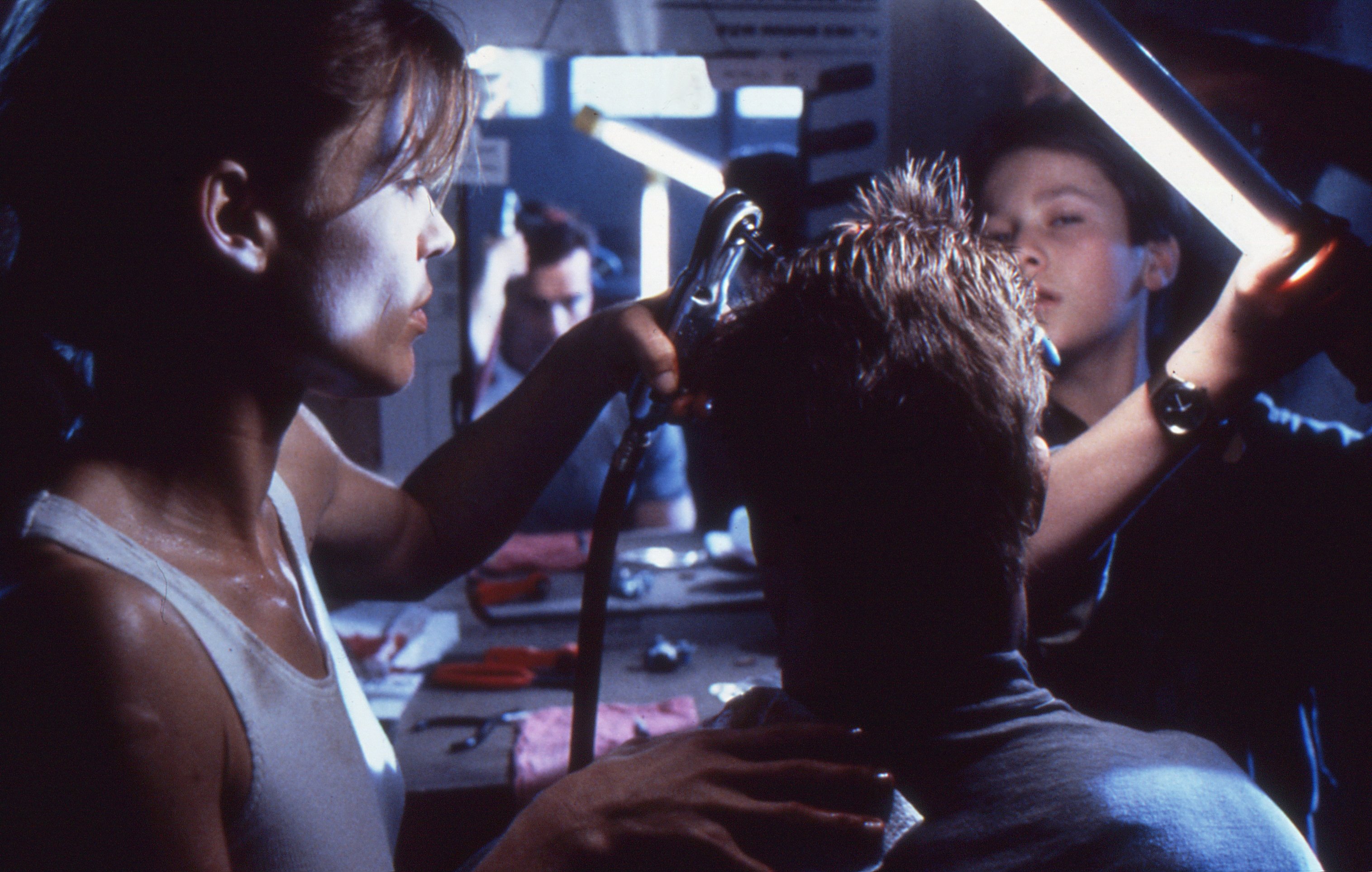
To create a consistent look for Terminator 2, Greenberg discovered he had to use three different stocks: Kodak 5297 for daytime interiors; 5245 for exterior day; and 5296 for night exteriors and all interiors. Greenberg was very impressed with Kodak's 5296, which he considers one of the major improvements on this production as opposed to the original film. "When we made the first film, they didn't have 96, so it was all shot using 93, which wasn't good stock. The 96 is much better. I think it gave us some very rich-looking colors. I worked a lot with gels to really stretch the colors of this movie. On one hand, I was going for a cold blue look, while on the other, I wanted it to look very warm and orange. The combination works well, and I was able to shoot both the white mental hospital and the dark, fiery steel mill at the end of the movie with this same stock, 96. I only changed the type of light and the colors."
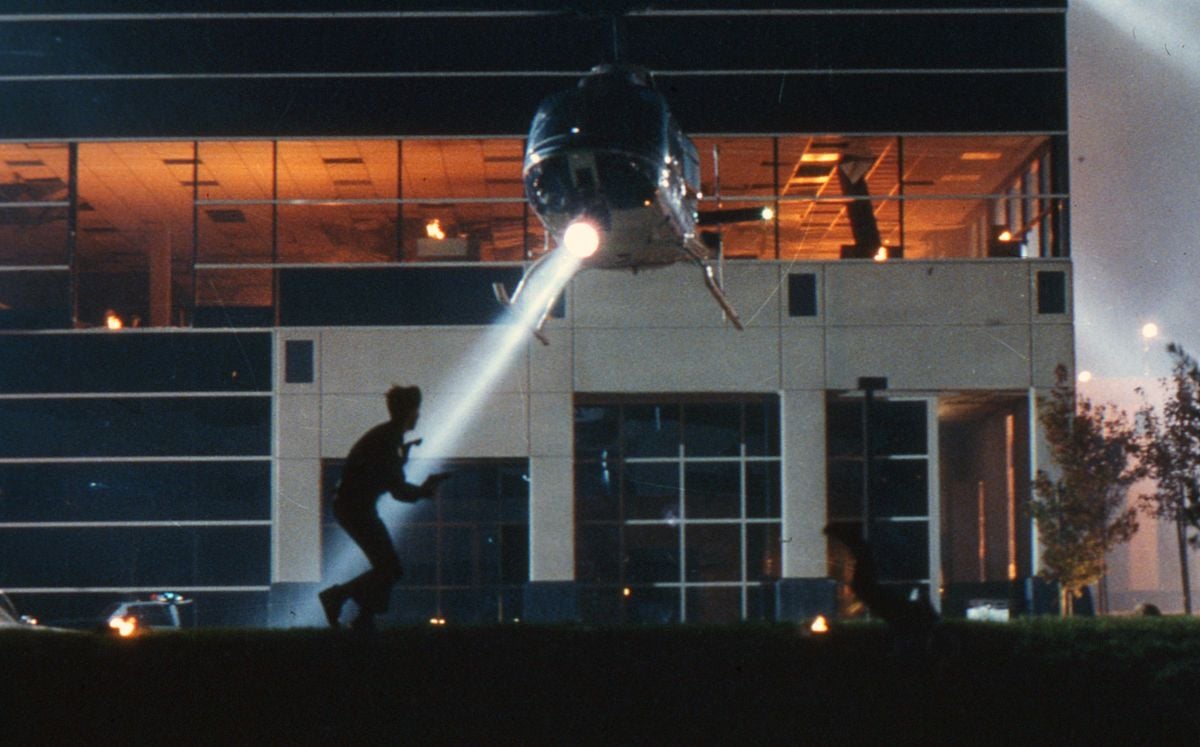
Although most of Terminator 2 was shot in Los Angeles, Cameron took his crew up to San Jose for three or four weeks to shoot an elaborate sequence outside the fictitious Cyberdyne Systems laboratory, the place where certain microchips in the Terminator's head were invented. The sequence involves the good Terminator breaking into and then escaping from the laboratory under seige. The interior of the Cyberdyne laboratory was a set built in Valencia, Calif., north of Los Angeles, which Greenberg lit primarily with practical lights. The exterior, on the other hand, was big and demanded special handling.
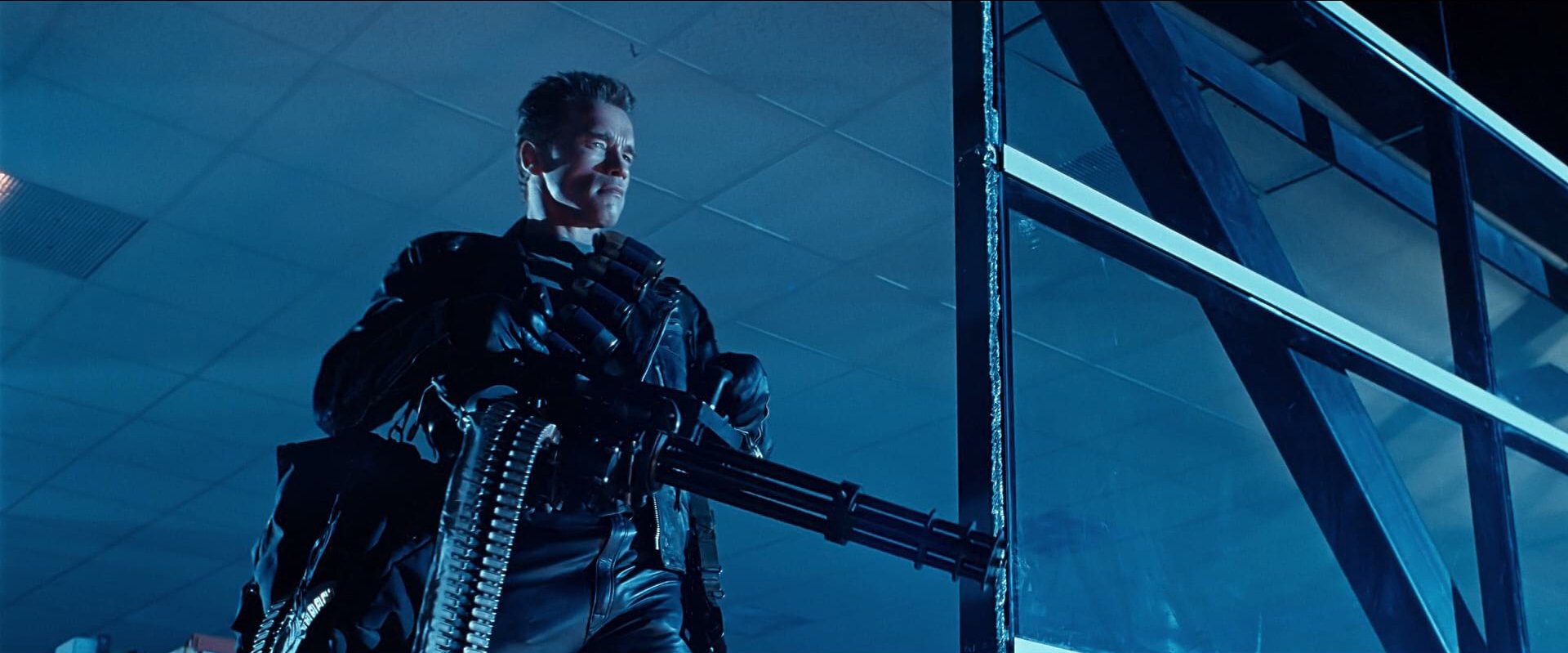
"The Cyberdyne laboratory was supposed to be a huge building and we planned a massive shootout between the Terminator and police, who arrive with their helicopter after someone sounds the alarm," Greenberg explains. "We knew we were going to have a lot of big action in this sequence — fire, shooting and explosions. We also wanted a number of shots of the police helicopter flying low, which meant there couldn't be any nearby electrical or telephone wires. We eventually shot only the exterior of the lab in San Jose because we couldn't find a building in the L.A. area that wouldn't interfere with helicopter activity."
As with the mental institution, Greenberg decided to stylize the look of the vast Cyberdyne Laboratory complex. "I felt it was like an army base, so I placed Xenon lights on the towers around the building to control the area," he notes. "I actually used those as practical lights to illuminate the set, along with a huge bright light on the helicopter. I think the audience will buy it and it's very effective. The sequence climaxed with a very big shootout, followed by a very big explosion. As the Terminator drives away, boom! Everything goes on fire!
“This explosion was the real thing,” Greenberg adds. "We shot it with 9 or 10 cameras on the ground and from the helicopter in the air. We had our cameras manned by very experienced guys and we relied very much on the judgment of our pyrotechnician, Tom Fisher. He was one of the best I ever worked with. We used Eyemos, remote cameras and cameras in insert cars in the more dangerous positions. This was one of the biggest explosions I'd ever handled, I must tell you. Jim [Cameron] is very precise, very careful not to expose people to any danger. I am impressed with this, because most directors don't know much about working with explosions; he knows a lot about it."

Since working with Cameron, Greenberg has become used to things blowing up on his sets, and he looks for new and improved ways of photographing them so the audience will get the most bang for the buck. "I don't like to shoot wide open stops; I light the scene," Greenberg says, "but, usually, when you have an explosion, it goes white. I knew I would have fire and special effects and smoke, and I knew I needed many cameras with long lenses. I didn't want to risk getting a soft focus on the flames; I didn't want them to look washed out, I wanted them to be orange and have texture, and I didn't want to lose the depth of the flames. I knew I had to build up the amount of light. I found that at or close to 5.6 the flames looked good.
"I knew what I was going for from the very beginning," Greenberg adds. "I knew I wasn't doing a variable light movie — I wasn't shooting two guys walking down Hollywood Boulevard; everything, all the action, was done for the cameras. I worked with a variable stop. The whole movie was done at 4.5 or 5.6, which made it easier for the assistant cameraman to pull focus in time. I had an incredibly good focus puller on this show: Dennis Laine. We didn't have many soft focus shots in 80 or 90 nights."
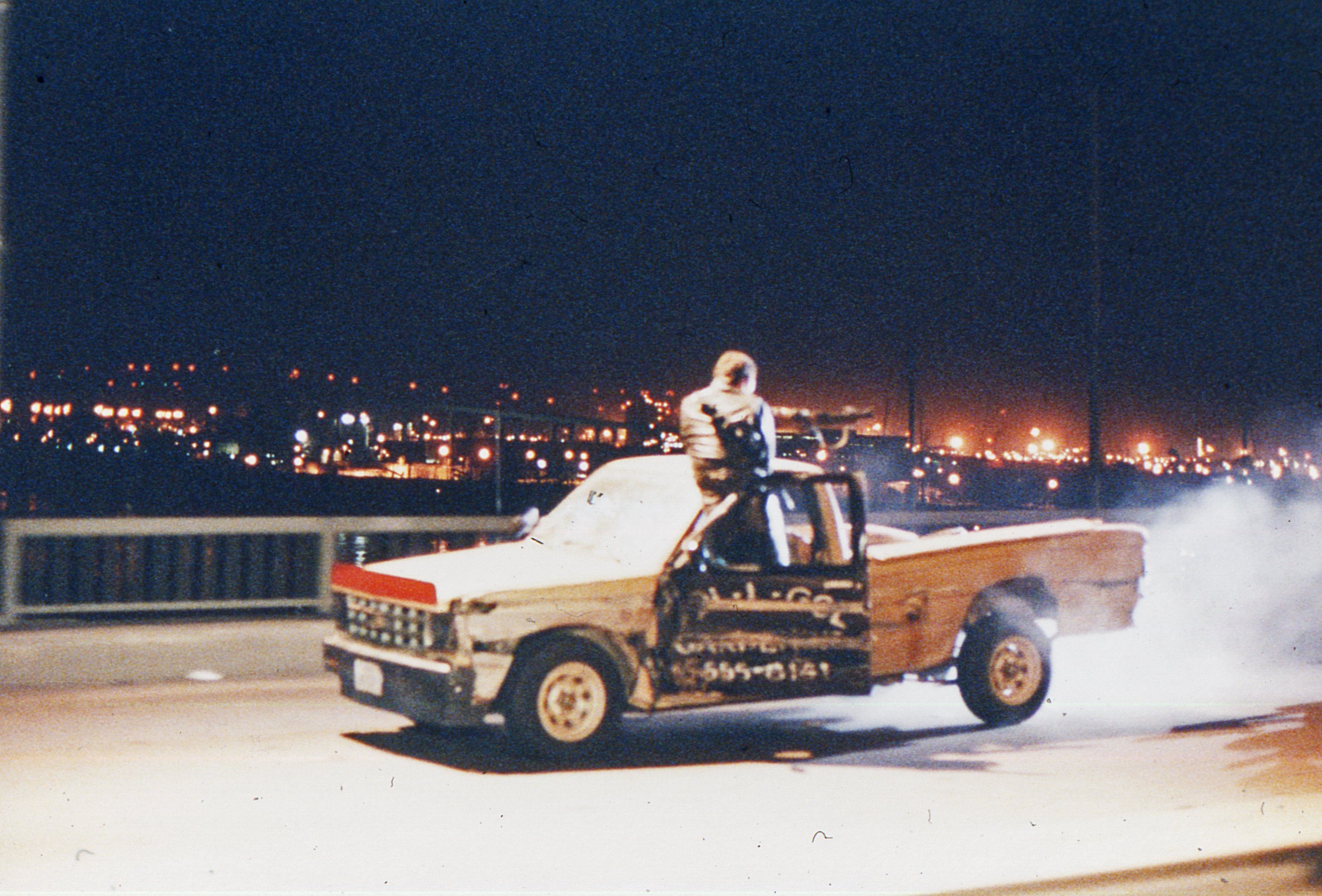
One of the most demanding night set pieces in this very demanding film was a chase sequence in which Arnold, Linda Hamilton and her son are in a truck on the Long Beach Freeway being followed by the Terminator T-1000 in a helicopter. "We had to light up the Long Beach Freeway for five and a half miles, just for this one scene," Greenberg marvels. "It was for an aerial shot from the helicopter as it chases the truck. The requirement of the director was that we do all five and a half miles in one piece, at one time, so we would be able to continuously shoot the run. Jim wanted to be able to shoot the sequence from the helicopter, from an insert car, from all over. It was tricky."
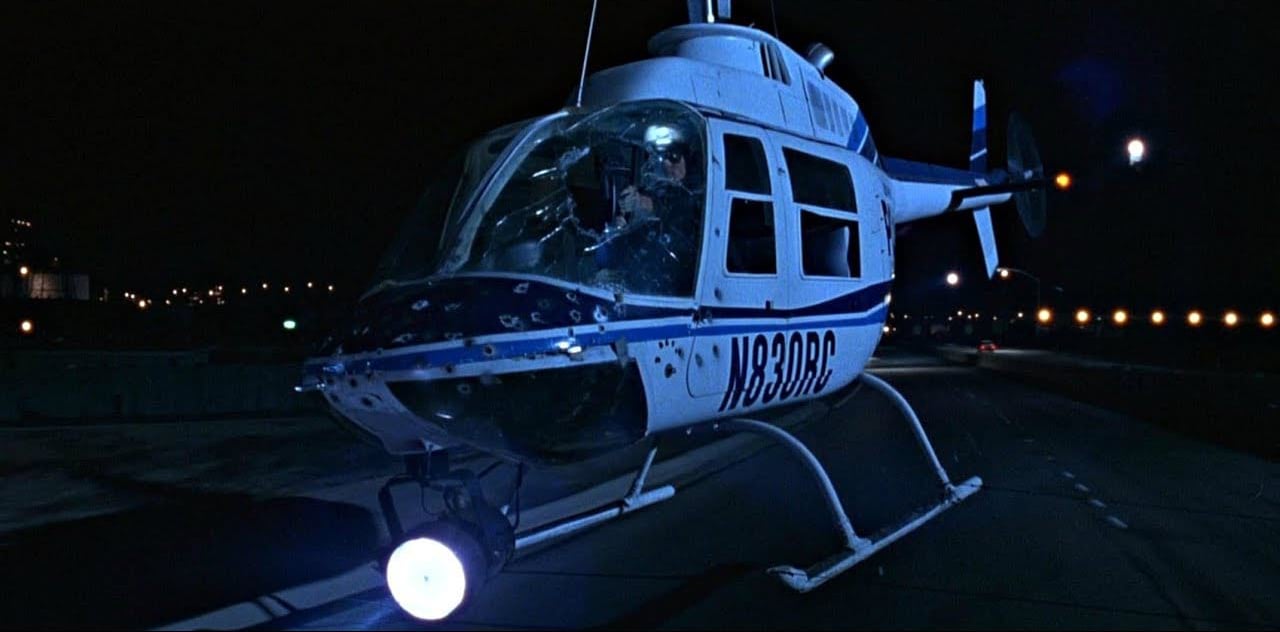
The most difficult part of the job turned out to be rigging the freeway for the lengthy night shoot. "We had to rent every existing cable from every studio — Paramount, Disney, Universal — there weren't enough cables in Hollywood to run this five and a half miles!" Greenberg laughs. "Then we had Musco lights and about 10 huge, 100-foot condor cranes with 12k HMIs on each of them. Altogether, we needed about 11 generators.
"I learned very quickly that on this size movie, I had to be very precise and do my homework very well. I had a very good gaffer, Gary Tondreau, who went with me to the location a few times. We drew up maps of the entire freeway so that we could decide very precisely what went where. We had to do this — the size of our crew and the amount of equipment we needed were very costly, and we had to be on schedule. We ended up needing a full crew who worked for two weeks only on this freeway to pre-rig all this stuff. While they were doing that, we needed policemen on the freeway who closed lanes for us and it was an incredibly big pressure. We shot for about three weeks on the freeway, all nights."
The climactic battle between the good Terminator and the Model T-1000 was staged at another abandoned steel mill in Oxnard, nearby the one that served as the backdrop for the future war sequence. Despite the fact that the mill was long since abandoned, Cameron wanted it to appear as though it were still operational. "Obviously, we couldn't shoot this in an operating steel mill," Greenberg explains. "We had found a steel mill that had been shut down since 1985 which was about to be dismantled and shipped to China. Basically, I needed to create the feeling that the mill was still working through lighting and special effects. Nothing existed in the steel mill, it was dead, so everything you see in the movie, the lighting, the steam, the pouring steel, is all artificial.
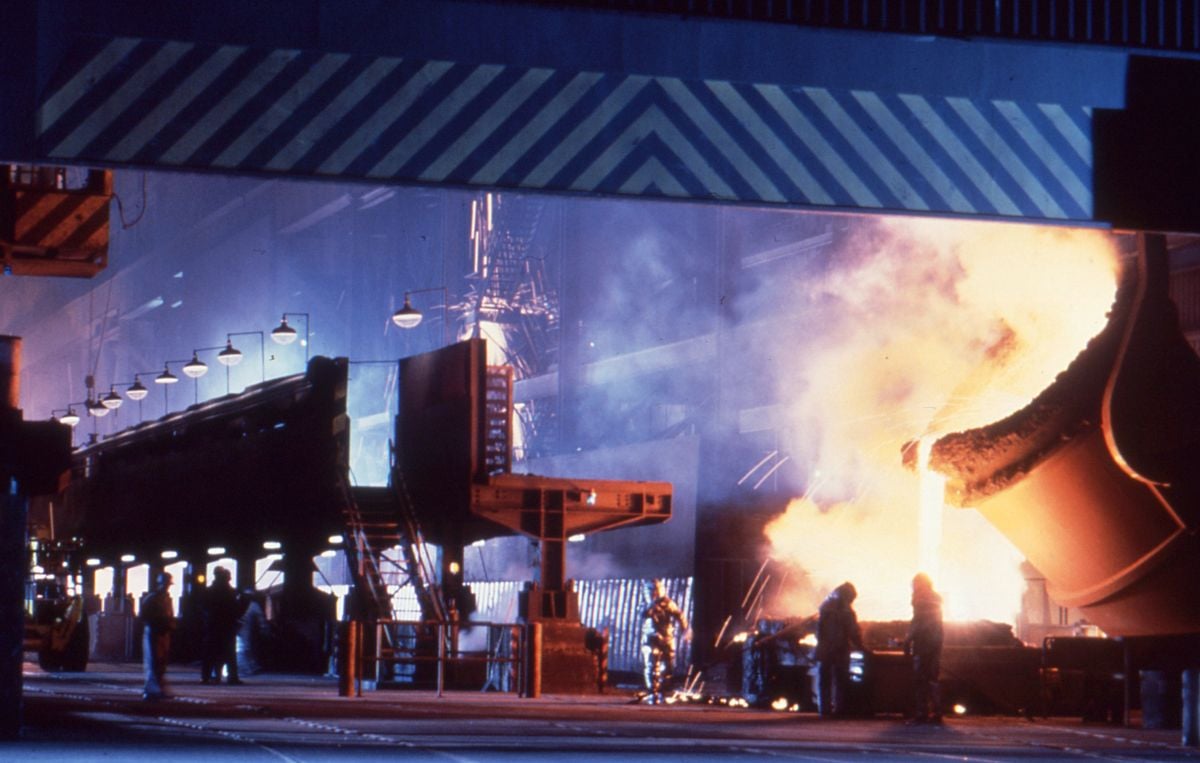
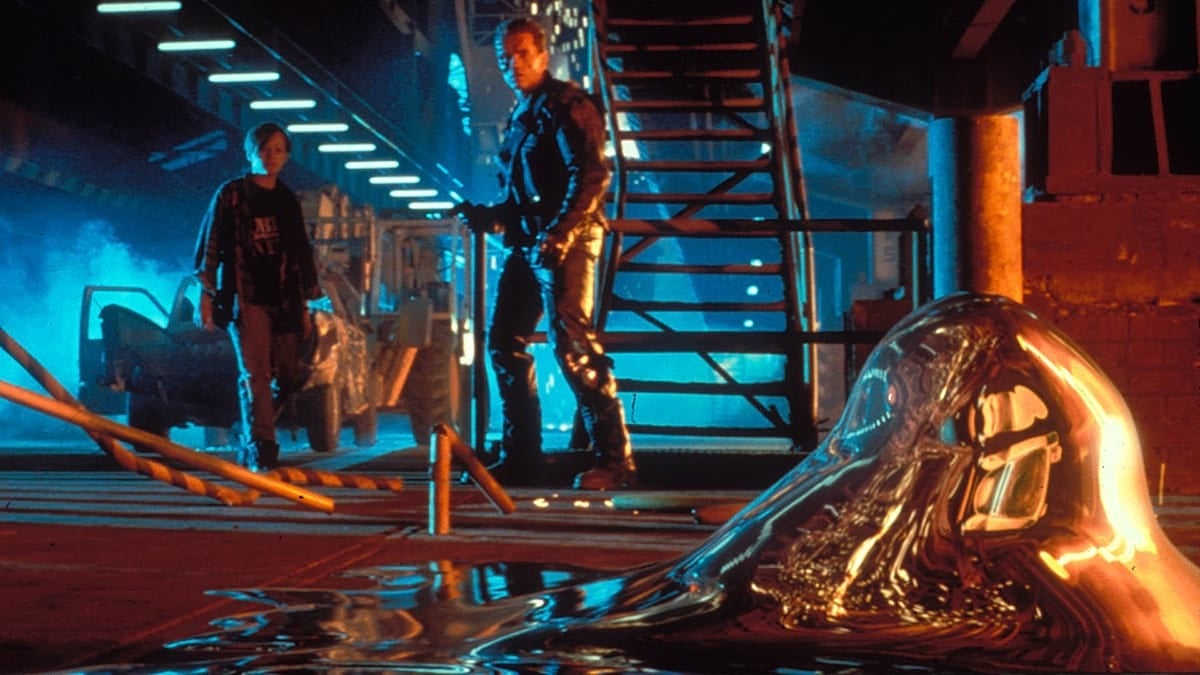
"There were two steel melting pots, one downstairs, the other upstairs," Greenberg recalls. "Underneath the pots we put huge numbers of maxi and mini brutes, and I think we ended with three or four hundred bulbs beneath each vat. It was so hot we couldn't keep the lights on between takes because they would melt the steel vat! I put three 85 gels on each of these 3200 Kelvin lights to make them warmer and more orange. I placed a plastic sheet over the lights, and on top of that, some water mixed with white powder and mineral oil to create some movement so it would look like there was molten steel in the pot. It was tricky because the purpose of all this was to make the pot look like it was heating up from inside.
"To add to the illusion, I put the lights on dimmers so we could create some flicker in the lighting to make the viewer think of flame. We also had heaters underneath the camera to create the ripple in the atmosphere you get from rising heat and then sparklers dropping in the background. These are not the sort of things the viewer should be paying attention to, but if I hadn't done them, they might miss it. It's incredible what we had to do to make it look like the steel mill was in operation so this movie would be believable!"
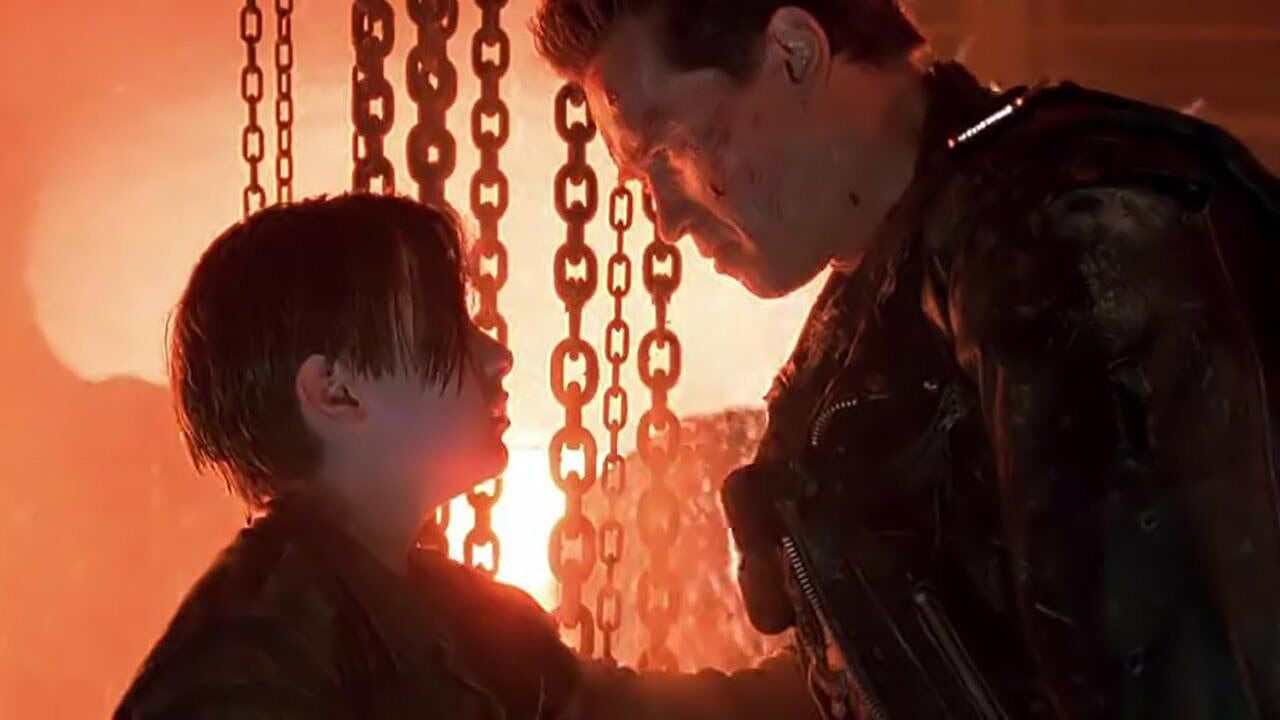
As remarkable as Greenberg's steel mill resurrection was the fact that he only used six generators to supply the power to all those lights beneath the melting pot, and his illusory "molten steel" became the source light for the scene. "I think you'll really believe it," he grins.
To preserve the depth of his images, Greenberg worked very closely with the laboratory, which harkened back to his earliest days in the film business, when he worked in a black-and-white film processing laboratory in Israel. "I understand very well how to work with the laboratory," he says. "For example, on this movie, I wanted to have the blackness be really black because there were so many night shots. I printed the whole show at very high lights: 47,48,46 on a scale of 1-50, because that gave me better blacks."
Greenberg's first outings as cinematographer occurred in Israel in the early 1960s, when he used to shoot black-and-white newsreels that were shown in theatres, much like the old Fox Movietone News. "I come from a documentary background; a lot of handheld camera," Greenberg says, adding wistfully, "but there's no documentary any more." Such a background made him the ideal cinematographer to capture the spontaneous excitement of the original Terminator, but Greenberg had begun his Israeli feature film career shooting love stories with dialogue and actors. He is still fearful of being typecast by Hollywood: "I like changes. This is a very tough industry and I was afraid I'd be doing action or horror films forever. Before The Terminator, I didn't do any science-fiction movies — I did war movies, love stories and comedies."
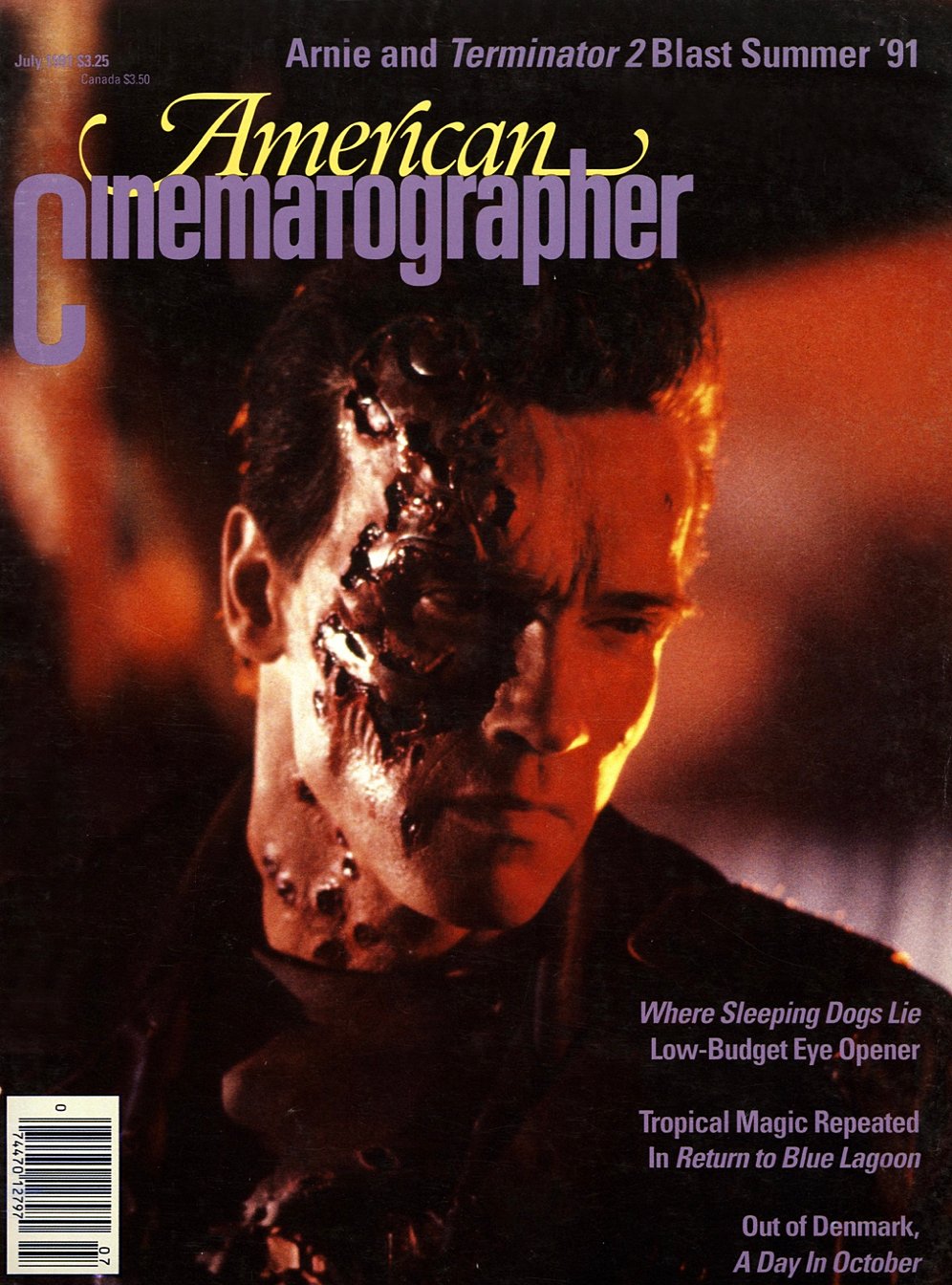
Thinking back on a career that began 30 years ago, Greenberg marvels at the technical advancements that have given cinematographers so much freedom in recent years: "The first time I ever came on a set, I remember there was a 10K, 5K, 10K, 5K," he says as he points to lights in different comers of an imaginary set. "We needed big lights to wash out the set because the negative wasn't sensitive. Today it's different — you turn on a practical here, a practical there and you can really create the right look; the negative, the stocks, the lenses, the laboratories allow you everything. Now is a very exciting time for photographers like me — there's so much opportunity, so many improvements. If you're not afraid to use them, incredible things will happen photographically."
Greenberg earned an Academy Award nomination for his expert camerawork in the picture, as well as an ASC Outstanding Achievement in Cinematography Award nomination and BSC Award nomination, among other accolades.
He was invited to become a member of the ASC in 1990 and is now retired.
You'll find a complete story with Dennis Muren, ASC on the visual effects work of Terminator 2 here.
AC Archive subscribers can access this entire issue, as well as more than 1,200 others. Subscribe here.






